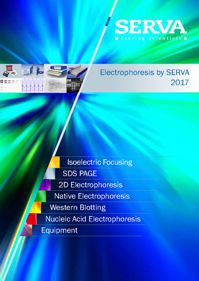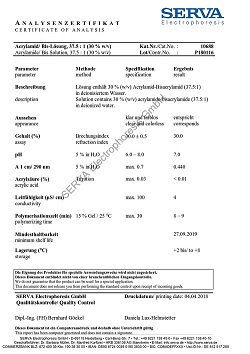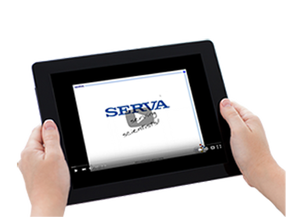Sodium azideresearch grade
NaN3 • Mr 65.01 • CAS [26628-22-8]
Sodium azide is commonly used as a bacteriostatic preservative in
biochemistry, molecular biology and cell biology.
It is also a metabolic
inhibitor of oxidative phosphorylation.
Assay (titr.)
|
min. 99.0 %
|
EG-Index: 011-004-00-7 •
GGVSE/ADR: 6.1 II UN1687 •
IATA: 6.1 II UN1687 •
EINECS: 247-852-1 •
WGK: 2L •
HS: 28500060
Storage Temperature: +15 °C to +30 °C
*Please use the inquiry form in the right column.
Package is subject to Dangerous Goods Regulations
Certificates of Analysis
(Lot.-no. - release date)
Material Safety Datasheets
You may find this also interesting:
Electrophoresis by SERVA - Catalog
Certificates of Analysis
now online!
Close window
In detail you will find all products of NZYtech in 2025:
| • |
New Supreme NZY Reverse Transcriptase 1 kU/µL |
| • |
Quality products for the life science research |
| • |
Diverese portfolio for moleculare biology |
| • |
Everything for DNA & RNA purification, Real Time and End-Point PCR and much more |
| • |
Various enzymes for Glycobiology |
nzytech_catalogue_2025.pdf
Close window
Certificates of Analysis
now online!
How to find the required certificate of analysis for your product:
In the search, enter the 5-digit article number without additional packaging, i.e. 11404 if you are looking for the AZ for your 500 g-Pack Agarose 11404.02.
Now click on the search result and you will be taken to the product entry. Here you will find the link "Certificate of Analysis", which you follow.
Now select the lot number from the list and download the PDF with a click. Done.
SERVA InfoMail - Get the latest information
Close window
When subscribing to »SERVA InfoMail« you will receive information about the latest product release, special promotions, new jobs at SERVA and more. This service is, of course, free of charge.
You may remove your name any time from the list of recipients.
Quick Order
Close window
Using the Quick Order field, you can add a product to your shopping cart with just one click. All you have to do: enter the Cat.No. as shown in our catalog in the format xxxxx.yy and click the Go!-Button.
Close window
H300
Deutsch:
Lebensgefahr bei Verschlucken.
English:
Fatal if swallowed.
Français:
Mortel en cas d'ingestion.
Italiano:
Letale se ingerito.
Español:
Mortal en caso de ingestión.
Close window
H310
Deutsch:
Lebensgefahr bei Hautkontakt.
English:
Fatal in contact with skin.
Français:
Mortel par contact cutané.
Italiano:
Letale per contatto con la pelle.
Español:
Mortal en contacto con la piel.
Close window
H330
Deutsch:
Lebensgefahr bei Einatmen.
English:
Fatal if inhaled.
Français:
Mortel par inhalation.
Italiano:
Letale se inalato.
Español:
Mortal en caso de inhalación.
Close window
H373
Deutsch:
Kann die Organe schädigen <alle betroffenen Organe nennen, sofern bekannt> bei längerer oder wiederholter Exposition <Expositionsweg angeben, wenn schlüssig belegt ist, dass diese Gefahr bei keinem anderen Expositionsweg besteht>.
English:
May cause damage to organs <or state all organs affected, if known> through prolonged or repeated exposure <state route of exposure if it is conclusively proven that no other routes of exposure cause the hazard>.
Français:
Risque présumé d'effets graves pour les organes <ou indiquer tous les organes affectés, s'ils sont connus> à la suite d'expositions répétées ou d'une exposition prolongée <indiquer la voie d'exposition s'il est formellement prouvé qu'aucune autre voie d'exposition ne conduit au même danger>.
Italiano:
Può provocare danni agli organi <o indicare tutti gli organi interessati, se noti> in caso di esposizione prolungata o ripetuta <indicare la via di esposizione se è accertato che nessun'altra via di esposizione comporta il medesimo pericolo>.
Español:
Puede provocar daños en los órganos <indíquense todos los órganos afectados, si se conocen> tras exposiciones prolongadas o repetidas <indíquese la vía de exposición si se ha demostrado concluyentemente que el peligro no se produce por ninguna otra vía>.
Close window
H400
Deutsch:
Sehr giftig für Wasserorganismen.
English:
Very toxic to aquatic life.
Français:
Très toxique pour les organismes aquatiques.
Italiano:
Molto tossico per gli organismi acquatici.
Español:
Muy tóxico para los organismos acuáticos.
Close window
H410
Deutsch:
Sehr giftig für Wasserorganismen mit langfristiger Wirkung.
English:
Very toxic to aquatic life with long lasting effects.
Français:
Très toxique pour les organismes aquatiques, entraîne des effets néfastes à long terme.
Italiano:
Molto tossico per gli organismi acquatici con effetti di lunga durata.
Español:
Muy tóxico para los organismos acuáticos, con efectos nocivos duraderos.
Close window
EUH 032
Deutsch:
Entwickelt bei Berührung mit Säure sehr giftige Gase.
English:
Contact with acids liberates very toxic gas.
Français:
Au contact d'un acide, dégage un gaz très toxique.
Italiano:
A contatto con acidi libera gas molto tossici.
Español:
En contacto con ácidos libera gases muy tóxicos.
Close window
P264
Deutsch:
Nach Gebrauch … gründlich waschen.
English:
Wash … thoroughly after handling.
Français:
Se laver … soigneusement après manipulation.
Italiano:
Lavare accuratamente … dopo l’uso.
Español:
Lavarse … concienzudamente tras la manipulación.
Close window
P273
Deutsch:
Freisetzung in die Umwelt vermeiden.
English:
Avoid release to the environment.
Français:
Éviter le rejet dans l’environnement.
Italiano:
Non disperdere nell’ambiente.
Español:
Evitar su liberación al medio ambiente.
Close window
P280
Deutsch:
Schutzhandschuhe/Schutzkleidung/Augenschutz/Gesichtsschutz tragen.
English:
Wear protective gloves/protective clothing/eye protection/face protection.
Français:
Porter des gants de protection/des vêtements de protection/un équipement de protection des yeux/du visage.
Italiano:
Indossare guanti/indumenti protettivi/Proteggere gli occhi/il viso.
Español:
Llevar guantes/prendas/gafas/máscara de protección.
Close window
P301 +P310
Deutsch:
BEI VERSCHLUCKEN: Sofort GIFTINFORMATIONSZENTRUM oder Arzt anrufen.
English:
IF SWALLOWED: Immediately call a POISON CENTER or doctor/physician.
Français:
EN CAS D’INGESTION: appeler immédiatement un CENTRE ANTIPOISON ou un médecin.
Italiano:
IN CASO DI INGESTIONE: contattare immediatamente un CENTRO ANTIVELENI o un medico
Español:
EN CASO DE INGESTIÓN: Llamar inmediatamente a un CENTRO DE INFORMACIÓN TOXICOLÓGICA o a un médico.
Close window
P302 +P352
Deutsch:
BEI KONTAKT MIT DER HAUT: Mit viel Wasser und Seife waschen.
English:
IF ON SKIN: Wash with plenty of soap and water.
Français:
EN CAS DE CONTACT AVEC LA PEAU: laver abondamment à l’eau et au savon.
Italiano:
IN CASO DI CONTATTO CON LA PELLE: lavare abbondantemente con acqua e sapone.
Español:
EN CASO DE CONTACTO CON LA PIEL: Lavar con agua y jabón abundantes.
Close window
P330
Deutsch:
Mund ausspülen.
English:
Rinse mouth.
Français:
Rincer la bouche.
Italiano:
Sciacquare la bocca.
Español:
Enjuagarse la boca.

















